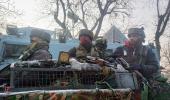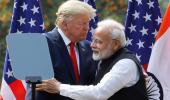Everybody talks of China as the real threat, but we aren't even building a decisive capability against Pakistan, asserts Shekhar Gupta.

We can start this story from the fateful night of December 9, 1971, at the peak of fighting in that war.
It was fateful because this was the night INS Khukri was sunk by the Pakistani submarine PNS Hangor, becoming the only ship the Indian Navy has lost to combat.
Instead of hiding, the Hangor had made its presence evident, setting up a bait.
India took up the challenge and sent out a three-ship formation optimised for anti-submarine warfare to hunt for it.
One ship, INS Kuthar, developed engine trouble and pulled back. The fact remains that all three had inadequate sonars.
Neither the Khukri nor the Kirpan spotted the Hangor. Two torpedoes fired at the Kirpan missed. The Khukri took three hits and sank almost instantaneously.
That's the reason for the high fatalities, with only 67 survivors. A tale of eternal regret, however, still hangs to this day.
Though the Indian Navy was aware of Pakistan's formidable submarine force, not enough had been done to build anti-submarine warfare (ASW) capabilities.
Even in this task force optimised for ASW, the sonars were inadequate.
India had had months to prepare for this war, yet when it began, an experimental sonar was being tested on the INS Khukri, in partnership with the Tata Group.
Now, which country sends out a 1,200-tonne warship with a jugaad sonar under testing? It obviously didn't work. And you know what?
An engineer from the Tata team working on this modification was aboard the Khukri on this mission. He became a rare civilian war casualty in action.
The reason we tell this story now is to underline the jugaad chalta hai, we-are too-big-to-bother-about-a-few-setbacks approach to our defence.
The virus afflicts both the political and civil services, as well as the military leadership.
That's how, despite knowing for years that Pakistani submarines were its only credible naval threat, India still had such poor sonars on its anti-submarine ships.
How much would it have cost to try and fill this gap? Very little.
But do such small fixes have the same appeal of buying a new ship, a submarine, a squadron of aircraft, or a new set of missiles?
And yet, this is how we suffer avoidable setbacks.
If this wasn't bad enough, the very next day added insult to injury. The navy flung all available resources to hunt for the Hangor.
One of these, a French-made Alize ASW two-engine aircraft, was shot down by a PAF F-104 loitering in ambush off the Kutch coast.
Overall, the navy had a stellar outing in the war, blotted by what could have been an avoidable loss.
How do we know any of this? Please check out Indian Navy 1965-1975: Transition to Triumph by Vice Admiral G M Hiranandani, published in 2000.
Vice Admiral Hiranandani was the head of the naval history project.
Also read Major General Ian Cardozo's The Sinking of INS Khukri: Survivors' Stories.
We can pick a dozen such stories from each of our engagements, where the forces went out to fight without vital elements -- mostly to do with technology -- which could have been avoided with greater alertness and commitment.

We can leapfrog to Pulwama-Balakot in 2019 when PAF AMRAAMs outranged all the IAF's missiles by a long distance, except probably the French MICA, with which fewer than 10 of its Mirages had been armed by then.
These had provided escort to the bombing mission over Balakot.
All the MiGs and Sukhois had the same Russian R-73s and R-77s.
That gap persisted until the Rafale became operational. And even now, work is on to equip the Sukhois with the swadeshi Astra to counter the AMRAAM, which the PAF has had since 2010.
You can see, therefore, that the missile gap was allowed to persist for nearly a decade.
It was important to tell this regrettable 1971 story, followed by the Pulwama-Balakot missile disadvantage, in detail because these are the starkest of all examples of our 'there-will-be-no-war', or 'we can handle it with our numbers, so what if there are initial casualties or setbacks' approach.
In both cases, almost 50 years apart, a much larger and more potent Indian force was put at a disadvantage just because some small but vital elements were lacking.
Over the past three decades, beginning with General V P Malik, we have had several chiefs say in frustration that we will fight with whatever we have.
The latest to say something similar is the current air chief.
Everybody talks of China as the real threat, but we aren't even building a decisive capability against Pakistan.

We have to understand the basics first. Before preparing for a big war, India needs clear deterrence against both likely adversaries.
With China, deterrence lies in making the costs of any aggression unaffordable.
For Pakistan, the deterrence has to be punitive, with no hope of face-saving retaliation.
For example, after Pulwama, if Balakot was bombed, such should have been the disparity in the IAF's favour that the PAF wouldn't even dare challenge it.
That's what happened during Kargil when the missile gap was in India's favour.
In the case of the Indian Army, for deterrence against both adversaries, the need is for long-range artillery, armed drones and copious volumes of loitering ammunition.
More smart artillery ammunition. That could be among the first list of purchases, if only a little more money becomes available.
Or modern, nippier air defence for forward units, given that the skies are going to be swarming with armed drones and cruise missiles.
The infantry also needs rapidly standardised gear, from small arms and protective equipment to shoes, helmets, secure communication, night vision, and modern anti-tank guided missiles.
We've been buying these in hundreds, and that's neither serious nor funny.

The falling IAF squadron strength will take time to address.
Meanwhile, just the acquisition of three or four more each of refuellers and AEW&C (Airborne Early Warning and Control Systems) will greatly multiply the current force levels.
In both these vital categories, we barely match the PAF, forget China.
In fact, the PAF has more AEW&C aircraft than us.
These do not have the same appeal as a big fighter order, but they need only a fraction of the money and would be a much faster force multiplier.
The navy desperately needs the heavyweight torpedoes for its Scorpene submarines, minesweepers, swarm boats and probably a 'navalised' version of the C-295 aircraft the Tatas are building in partnership with Airbus.
These will be force multipliers too, as these reduce the workload of the 12 P-8is by taking over the medium-range surveillance and ASW (eight hours of flying time) duties.
Given the limited budget for acquisitions, much of the funds will be allocated to the few big capital purchases, ongoing or impending.
The additional money should be utilised mostly to fill these critical gaps in the short run to build force multipliers and minimum deterrence against each adversary.
And finally, how to raise the money? First, minimal increases like these, about 0.2 per cent of GDP each year, can be pretty much tweaked into our ongoing Budgets.
Even an increase by 0.1 per cent of GDP, from 1.9 per cent now to 2, will bring in another Rs 30,000 crore (Rs 300 billion) for acquisitions.
But if that's onerous for the finance ministry, an aggressive new round of privatisation could be carried out, with the proceeds allocated to defence.
Nothing could be more public opinion friendly.
By special arrangement with The Print
Feature Presentation: Aslam Hunani/Rediff.com












 © 2025
© 2025